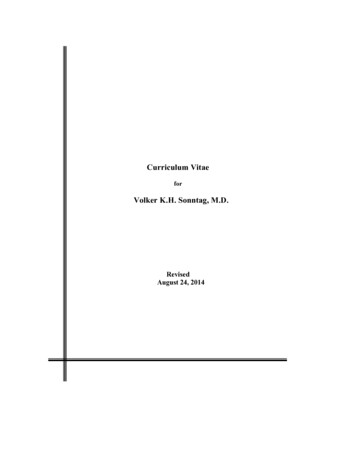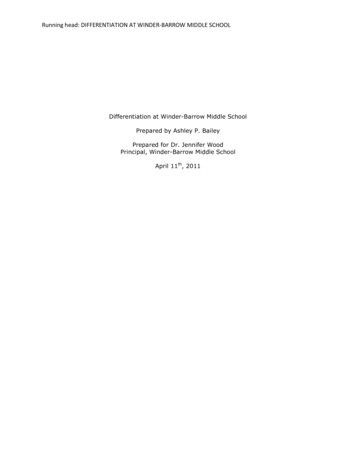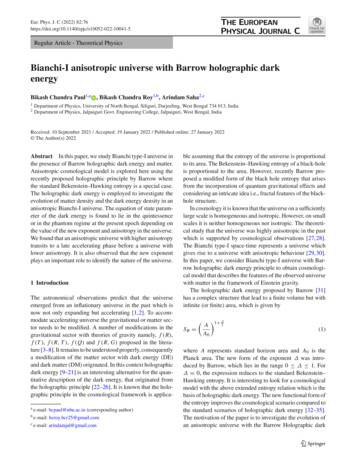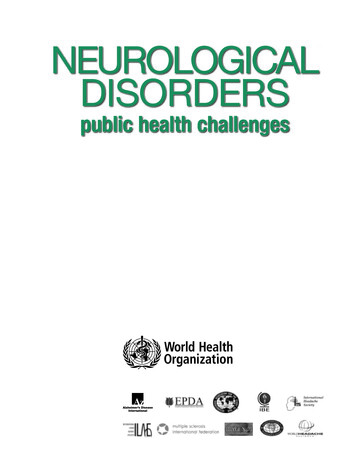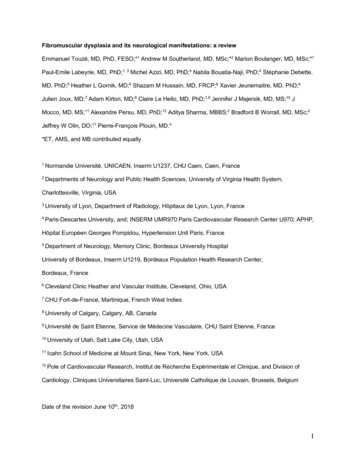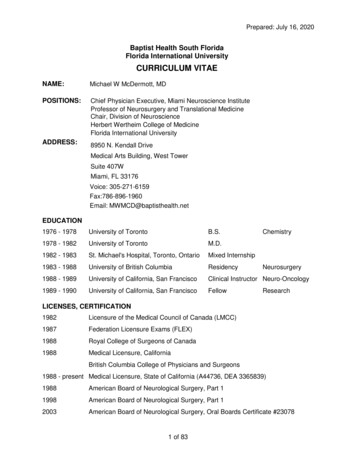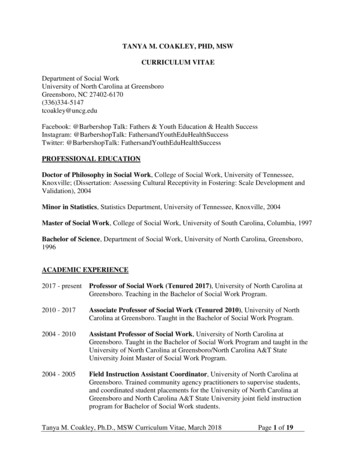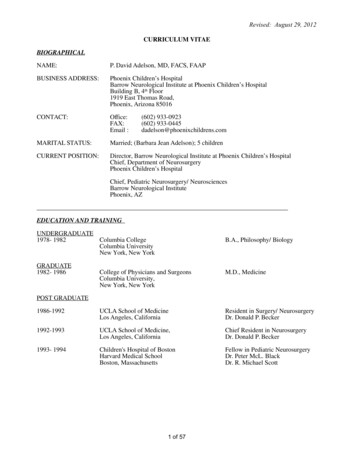
Transcription
Revised: August 29, 2012CURRICULUM VITAEBIOGRAPHICALNAME:P. David Adelson, MD, FACS, FAAPBUSINESS ADDRESS:Phoenix Children’s HospitalBarrow Neurological Institute at Phoenix Children’s HospitalBuilding B, 4th Floor1919 East Thomas Road,Phoenix, Arizona 85016CONTACT:Office:FAX:Email :MARITAL STATUS:Married; (Barbara Jean Adelson); 5 childrenCURRENT POSITION:Director, Barrow Neurological Institute at Phoenix Children’s HospitalChief, Department of NeurosurgeryPhoenix Children’s Hospital(602) 933-0923(602) 933-0445dadelson@phoenixchildrens.comChief, Pediatric Neurosurgery/ NeurosciencesBarrow Neurological InstitutePhoenix, AZEDUCATION AND TRAININGUNDERGRADUATE1978- 1982Columbia CollegeColumbia UniversityNew York, New YorkGRADUATE1982- 1986B.A., Philosophy/ BiologyCollege of Physicians and SurgeonsColumbia University,New York, New YorkM.D., Medicine1986-1992UCLA School of MedicineLos Angeles, CaliforniaResident in Surgery/ NeurosurgeryDr. Donald P. Becker1992-1993UCLA School of Medicine,Los Angeles, CaliforniaChief Resident in NeurosurgeryDr. Donald P. Becker1993- 1994Children's Hospital of BostonHarvard Medical SchoolBoston, MassachusettsFellow in Pediatric NeurosurgeryDr. Peter McL. BlackDr. R. Michael ScottPOST GRADUATE1 of 57
P. David Adelson, MD, FACS, FAAPCurriculum VitaeCURRENT APPOINTMENTS AND POSITIONS2009 –Director, Phoenix Children’s Neuroscience InstituteChief, Pediatric Neurosurgery/ Neurosciences, Phoenix Children’s Hospital,Phoenix, AZ2009 –Adjunct Faculty, School of Biological and Health Systems Engineering, ArizonaState University Tempe, AZ2009 –Affiliate Research Faculty, Arizona Emergency Medicine Research Center,University of Arizona, Tucson, AZ2009 –Neurological Surgery Faculty, Barrow Neurological Institute, Phoenix, AZ2010 –Clinical Professor of Surgery/Neurosurgery, University of Arizona, Phoenix, AZ2011 –Chief, Pediatric Neurosurgery/Neurosciences, Barrow Neurological Institute,Phoenix, AZ2011 –Director, Barrow Neurological Institute at Phoenix Children’s Hospital, Phoenix, AZPREVIOUS APPOINTMENTS AND POSITIONS2007 – 2008A. Leland Albright Endowed Chair of Neurological Surgery/Pediatric Neurosurgery2003 – 2008Vice Chairman (Research), Department of Neurosurgery, University of PittsburghMedical Center, Pittsburgh, PA (Reappointed 2007)2003 – 2008Professor of Neurosurgery, (Tenured), University of Pittsburgh School of Medicine,Children’s Hospital of Pittsburgh, Pittsburgh, PA1999 – 2003Associate Professor of Neurosurgery, (Tenured), University of Pittsburgh School ofMedicine, Children’s Hospital of Pittsburgh, Pittsburgh, PA1994 – 1999Assistant Professor of Neurosurgery, Children's Hospital of PittsburghUniversity of Pittsburgh, Pittsburgh, PA2008Director, Center for Injury Research and Control (CIRCL), University ofPittsburgh, Pittsburgh, PA2003 – 2008Director, Walter L. Copeland Neurosurgical Research Laboratory, University ofPittsburgh, Pittsburgh, PA1997 – 1998Associate Director, Center for Injury Research and Control (CIRCL), University ofPittsburgh, Pittsburgh, PA1995 – 2008Director, University of Pittsburgh Brachial Plexus/ Peripheral NerveInjury Center, Pittsburgh, PA1994 – 2008Director, University of Pittsburgh Surgical Epilepsy Program, Pittsburgh, PA1994 – 2008Director, Children’s Hospital of Pittsburgh Pediatric Neurotrauma,1999 – 2008Associate Director, General Clinical Research Center (GCRC), Children’sHospital of Pittsburgh, Pittsburgh, PA1998 – 2005Associate Medical Director, Benedum Trauma Center, Children’s Hospital2 of 57
P. David Adelson, MD, FACS, FAAPCurriculum Vitaeof Pittsburgh, Pittsburgh, PA1995 – 2005Director of Trauma Research, Benedum Trauma Center, Children’sHospital of Pittsburgh, Pittsburgh, PA1998- 1999Member, Pittsburgh Adolescent Alcohol Research Center (PAARC)1998- 1999Member, Center for Education and Drug Abuse Research (CEDAR)1995- 2008Consultant Staff, The Rehabilitation Institute, Pittsburgh, PA1995- 2008Consultant Staff, Veteran's Administration Medical Center, Pittsburgh, PA1995- 2008Visiting Scientist, Safar Center for Resuscitation Research, Pittsburgh, PAPrivileges2009 - PresentPhoenix Children’s Hospital, Phoenix, AZ2009 - PresentSt. Joseph's Children's Health Center, Phoenix, AZ2009 - PresentBarrow Neurological Institute, Phoenix, AZ2011 – PresentMaricopa Integrated Health Services, Phoenix, AZCERTIFICATION AND LICENSURESpecialty CertificationNovember 2009American Board of Pediatric Neurological Surgery, RecertifiedApril 27, 1998American Board of Pediatric Neurological SurgeryNovember 12, 1997American Board of Neurological Surgeons1987National Boards Part I, II, and III1992American Board of Neurological Surgery, Primary ExamAdvanced Trauma Life Support (ATLS)Medical Licensure1994Pennsylvania MD-052592-L2008Arizona MD # 41252VISITING PROFESSORSHIPS AND INVITED/ NAMED LECTURESHIPS20122nd Annual J. Douglas Miller Lecturer, AANS/ CNS Section for Neurotrauma and Critical Care.American Association of Neurological Surgeons. Miami, FL. April 20122011Invited Lecturer. 14th World Federation of Neurosurgical Society. Recife, Brazil. September 20113 of 57
P. David Adelson, MD, FACS, FAAPCurriculum VitaeInvited Lecturer. EANS Training Course. Marseille France. August 2011Keynote Speaker. 6th World Congress of Pediatric Critical Care, Sydney, Australia, March201116th Annual Congress of the Spanish Society of Neurosurgery, Madrid, Spain, May 20112010Anthony Gallo Jr. Lectureship and Visiting Professorship, Oregon Health & ScienceUniversity Portland, Oregon, February 2010Keynote Speaker. 5th Annual Traumatic Brain Injury Symposium, Barrow NeurologicalInstitute, Phoenix, AZ, March 26, 2010Keynote Speaker, Karolinska University Stockholm, Sweden June 2010Visiting Professor, University of Florida, McKnight Institute and Department ofNeurosurgery, Gainesville, Florida, June 2010Keynote Speaker. 14th International Intracranial and Brain Monitoring Symposium,Tubingen, Germany, September 14, 2010Peter N. Tandon Honored Lecturer. NEUROCON 2010 Neurosurgical Society of India andCongress of Neurological Surgeons, Jaipur, India, December 2010.2008Semmes Murphy Clinic, University of Tennessee, Department of Neurosurgery, Memphis,Tennessee, January, 2008Distinguished Visiting Neurosurgeon, University of Connecticut, Connecticut Children’sHospital, Hartford, Connecticut, April, 2008Visiting Professor, Phoenix Children’s Hospital, Children’s Neuroscience Institute, Phoenix,Arizona, June, 2008Visiting Professor, UCLA School of Medicine, Los Angeles, CA, December, 2008Visiting Professor, Children’s Hospital of Los Angeles, Los Angeles, CA, December, 20082007Keynote Speaker, University of Nevada, Las Vegas, 1st Annual Pediatric TraumaSymposium, Las Vegas, NVJohn and Sabina Frew Lectureship/ Visiting Professorship, Indiana Neurosurgical/ IndianaUniversity, Indianapolis, IndianaVisiting Professor, Louisiana State University, Shreveport, Department of Neurosurgery,Shreveport, LouisianaVisiting Professor, Virginia Commonwealth University, Department of Anatomy, Richmond,Virginia2006Visiting Professor, University of Medicine and Dentistry, Department of Neurosurgery, NewJersey, Newark, New Jersey2003Visiting Professor, University of Florida, McKnight Institute and Department ofNeurosurgery, Gainesville, FloridaVisiting Professor, Schneider Children’s Hospital, Department of Neurosurgery, LongIsland, New York4 of 57
P. David Adelson, MD, FACS, FAAPCurriculum Vitae2000Visiting Professor, University of California, Los Angeles, Department of Neurosurgery, LosAngeles, California1998Visiting Professor, University of Arkansas, Department of Neurosurgery, Little Rock,Arkansas1999Visiting Professor, Valley Children’s Hospital, Department of Pediatrics, University ofCalifornia, San Francisco, California1999Visiting Professor, Temple University, Department of Neurosurgery, Philadelphia,Pennsylvania1995John Heberling Memorial Lecture, Pittsburgh, PennsylvaniaMEMBERSHIPS IN PROFESSIONAL AND SCIENTIFIC SOCIETIESAmerican Academy of PediatricsAmerican Academy of Neurological SurgeonsAmerican Association of Neurological SurgeonsAmerican College of SurgeonsAmerican Epilepsy SocietyAmerican Society of Pediatric NeurosurgeonsCongress of Neurological SurgeonsHydrocephalus AssociationInternational Neurotrauma SocietyInternational Society for Pediatric NeurosurgeryJoint Section on Pediatric Neurosurgery (AANS/ CNS)Joint Section on Neurotrauma and Critical Care (AANS/ CNS)National Neurotrauma SocietySociety of University NeurosurgeonsHONORS / AWARDS2011Best Doctors of America- Neurological Surgery (Top 1% in United States)2011Surgeon of the Year, Arizona Business Times2010Best Doctors of America-Neurological Surgery/Pediatric Neurosurgery2010Who's Who in America2010America’s Top Doctor2009Who's Who Among Executives and Professionals2009Best Doctors of America-Neurological Surgery/Pediatric Neurosurgery2008Best Doctors of America-Neurological Surgery/Pediatric Neurosurgery2007Best Doctors of America-Neurological Surgery/Pediatric Neurosurgery2006Best Doctors of America-Neurological Surgery/Pediatric Neurosurgery2002Best Doctors of America- Neurological Surgery/ Pediatric Neurosurgery2002Honored Member, Strathmore’s Who’s Who Edition 2002-20035 of 57
P. David Adelson, MD, FACS, FAAPCurriculum Vitae2001Outstanding Surgeon, Honorable Mention, Critical Care Staff Award2000Fellow, American Academy of Pediatrics1999Fellow, American College of Surgeons1998Young Investigator Award, Brain Injury Association1998Best Doctors of America- Neurological Surgery/ Pediatric Neurosurgery1998Congress of Neurological Surgeons Clinical Investigation ScholarshipAward1996Best Doctors of America: Northeast- Neurological Surgery/ PediatricNeurosurgery1995Dr. John A. Heberling Memorial Lecturer1993Outstanding Physician Award- UCLA Medical Center Nursing Service1992Giannini Foundation Postdoctoral Scholar1992Kenneth Shulman Award- Pediatric Section of AANS (Award for Excellencein Resident Research)1991New Medico Head Injury Sponsorship- (Award for Head Injury Research)1981Volunteer Service Award- Greater New York ServicesPUBLICATIONSREFEREED ARTICLES1.Marboe C, Schwartz RA, Adelson D, Escala E, Weiss M, Fenoglio J. Active myocarditis withfibrosis: Poor correlation of ejection fraction with histology of follow-up biopsy. European HeartJournal 8: Suppl. J: 1987.2.Hovda DA, Villablanca JR, Adelson PD. Anatomical and metabolic cortico-tectal neuroplasticityafter neonatal cerebral hemispherectomy: Correlations with visual field sparing. Brain Dysfunction5:3-26, 1992.3.Adelson PD, Peacock WJ, Chugani H, Comair Y, Vinters H, Shields WD, Shewmon DA. Temporaland extended temporal resection in early childhood. Pediatric Neurosurgery 18:169-178, 1992.4.Sutton RL, Hovda DA, Adelson PD, Benzel EC, Becker DP. Metabolic changes following corticalcontusion: Relationships to edema and morphological changes. Acta Neurochirurgica (Suppl.) 60:446- 448, 1994.5.Adelson PD, Black PMcL, Kramer U, Rockoff MA, Riviello J, Helmers SL, Mikati M, Holmes G,Madsen JR. The use of grid and strip electrodes to identify a seizure focus in children. PediatricNeurosurgery 22: 174- 180, 1995.6.Adelson PD, Hovda DA, Villablanca JR, Tatsukawa K. Development of a crossed corticotectalpathway following cerebral hemispherectomy in cats: A quantitative study of the projecting neurons.Developmental Brain Research 86 :81- 93, 1995.6 of 57
P. David Adelson, MD, FACS, FAAPCurriculum Vitae7.Adelson PD, Scott RM. Pial synangiosis for Moyamoya in children. Pediatric Neurosurgery 23: 2633, 1995.8.Pollack IF, Albright AL, Adelson PD, Fitz C. The role of frameless stereotactic techniques in thetreatment of pediatric central nervous system lesions. Pediatric Neurology 13: 209- 216, 1995.9.Chiang V, Adelson PD, Young-Poussaint T, Parades A, Churchwell KB. Brain abscesses due toClostridium Septicum as a complication of Hemolytic Uremic Syndrome. The Pediatric InfectiousDisease Journal. 14: 1: 72- 74, 1995.10.Adelson PD. The surgical treatment of epilepsy in children. Contemporary Neurosurgery. 17: 23: 18, 1995.11.Furst SR, Sullivan LN, McDermott JS, Soriano S, Adelson PD, Rockoff MA. Effects of ondansetronon emesis in the first 24 hours after craniotomy in children. Anesthesia and Analgesia 83:325- 328,1996.12.Mathern GW, Leite JP, Babb TL, Pretorius JK, Kuhlman PA, Mendoza D, Fried I, Sakamoto AC,Assirati JA, Adelson PD, Peacock WJ. Aberrant hippocampal mossy fiber sprouting correlates withgreater NMDAR2 receptor staining. Neuro Report 7: 5: 1029- 1035, 1996.13.Gerszten PC, Adelson PD, Kondziolka D, Pollack IF, Flickinger JC, Lunsford LD. Seizure controlin children treated for arteriovenous malformations by radiosurgery. Pediatric Neurosurgery 24: 139144, 1996.14.Adelson PD, Robichaud RJ, Hamilton RL, Kochanek PM. A model of diffuse traumatic brain injuryin the immature rat. Journal of Neurosurgery 85: 5: 877- 884, 1996.15.Losken HW, Pollack IF, Singhal VK, Adelson PD. Endoscopic vascularized fronto-orbitaladvancement: Preliminary Report. Craniofacial Surgery 6: 253- 256, 1996.16.Adelson PD, Firlik K, Firlik A, Hamilton RL. A thoracic extradural meningeal cyst presenting asprolonged paresis following an ankle injury. Neuropediatrics. 27: 207- 210, 1996.17.Kondziolka D, Adelson PD. Technique of stereotactic biopsy in a 5 month old child. Child'sNervous System. 12: 615- 618, 1996.18.Lowry DW, Lowry DL, Berga SL, Adelson PD, Roberts MM. Secondary amenorrhea due tohydrocephalus treated with endoscopic ventriculocisternostomy. Case report. Journal ofNeurosurgery. 85: 1148- 1152, 1996.19.Lynch J, Meza MP, Pollack IF, Adelson PD. Direct injury to the cervical spine of a child by a lapshoulder belt resulting in quadriplegia: Case report. Journal of Trauma-Injury Infection & CriticalCare 41: 747- 749, 1996.20.Adelson PD. The surgical management of epilepsy in childhood. Neurosurgery Quarterly. 6(1): 120, 1996.21.Adelson PD, Dixon CE, Robichaud RJ, Kochanek PM. Motor and cognitive functional deficitsfollowing diffuse traumatic brain injury in the immature rat. Journal of Neurotrauma 14: 99-108,1997.22.Bell M, Kochanek PM, Doughty LA, Carcillo JA, Adelson PD, Clark RSB, Wisniewski SR, WhalenMJ, DeKosky ST: Interleukin-6 and Interleukin-10 in Cerebrospinal Fluid after Traumatic BrainInjury in Children. Journal of Neurotrauma 14:451-457, 1997.7 of 57
P. David Adelson, MD, FACS, FAAPCurriculum Vitae23.Lowry DW, Pollack IF, Clyde B, Albright AL, Adelson PD. Upper cervical spine fusion in thepediatric population. Journal of Neurosurgery 87: 671-676, 1997.24.Bell MJ, Kochanek PM, Doughty LA, Carcillo JA, Adelson PD, Clark RSB, Whalen MJ, DeKoskyST. Comparison of the interleukin-6 and interleukin-10 response in children after severe traumaticbrain injury or septic shock. Acta Neurochirurgica 70:96-97, 1997.25.Mathern GW, Pretorius JK, Kornblum HI, Mendoza D, Lozada A, Leite JP, Chimelli LMC, Fried I,Sakamoto AC, Assirati JA, Levesque MF, Adelson PD, Peakcock WJ. Human hippocampal AMPAand NMDA mRNA levels in temporal lobe epilepsy patients. Brain 120:1937-1959, 1997.26.Adelson PD, Clyde B, Kochanek PM, Wisniewski S, Marion DW, Yonas H. Cerebrovascularresponse in infants and young children following severe traumatic brain injury: A preliminaryreport. Pediatric Neurosurgery 26:200-207, 1997.27.Bell M, Kochanek PM, Doughty LA, Carcillo JA, Adelson PD, Clark RSB, Wisniewski SR, WhalenMJ, DeKosky S. Interleukin-6 and Interleukin-10 in cerebrospinal fluid after traumatic brain injuryin children. Journal of Neurotrauma 14:451-457, 1997.28.Adelson PD, Nemoto EM, Painter M. The use of near-infrared spectroscopy (NIRS) in childrenafter traumatic brain injury: A preliminary report: ICPX A Marmarou, R Bullock, et al. (eds). ActaNeurochirurgica Supplementum 71:250-254, 1998.29.Adelson PD, Whalen M, Robichaud P, Carlos T, Kochanek P. Blood brain barrier permeability andacute inflammation in two models of traumatic brain injury in the immature rat: A preliminaryreport: ICPX A Marmarou, R Bullock, et al. (eds). Acta Neurochirurgica Supplementum 71:104106, 1998.30.Adelson PD, Kochanek PM. Head injury in children. Journal of Child Neurology. 13:2-15, 1998.31.Mathern GW, Pretorius JK, Mendoza D, Lozada A, Leite JP, Chimelli L, Fried I, Sakamoto AC,Assirati JA, Adelson PD. Increased hippocampal APMA and NMDA receptor immunoreactivity intemporal lobe epilepsy patients. Journal of Neuropathology and Experimental Neurology 57:615634, 1998.32.Gerszten PC, Albright AL, Pollack IF, Adelson PD. Intraoperative hypothermia and ventricularshunt infections. Acta Neurochirurgica 140 (6): 591- 594, 1998.33.Mathern GW, Pretorius JK, Kornblum HI, Mendoza D, Lozada A, Leite JP, Chimelli L, Born DE,Fried I, Sakamoto AC, Assirati JA, Peacock WJ, Ojemann GA, Adelson PD. Altered hippocampalkainate-receptor mRNA levels in temporal lobe epilepsy patients. Neurobiology of Disease, 5:151176, 1998.34.Whalen MJ, Carlos TM, Kochanek PM, Wisniewski SR, Bell MJ, Clark RSB, DeKosky ST, AdelsonPD. Soluble adhesion molecules in CSF are increased in children with severe head injury. Journalof Neurotrauma. 15:777-787, 1998.35.Mathern GW, Mendoza D, Lozada A, Pretorius JK, Danbolt NC, Dehnes Y, Nelson N, Leite JP,Chimelli LMC, Borne DE, Fried I, Sakamoto AC, Assirati JA, Peacock WJ, Ojemann GA, AdelsonPD. Hippocampal GABA and glutamate transporter immunoreactivity in temporal lobe epilepsypatients. Neurology. 52: 453-472, 1999.36.Adelson PD. Animal models of traumatic brain injury in the immature: A review. Experimental andToxicologic Pathology 51:130-136, 1999.8 of 57
P. David Adelson, MD, FACS, FAAPCurriculum Vitae37.Firlik KS, Adelson PD. Large chronic cephalohematoma without calcification. PediatricNeurosurgery 30:39-42, 199938.Bell MJ, Kochanek PM, Heyes MP, Wisniewski SR, Sinz EH, Clark RSB, Blight AR, Marion DW,Adelson PD. Quinolinic acid in the cerebrospinal fluid of children after traumatic brain injury.Critical Care Medicine 27:493-497, 1999.39.Scarrow AM, Levy EI, Resnick DK, Adelson PD, Sclabassi RJ. Cervical spine evaluation inobtunded or comatose pediatric trauma patients: a pilot study Pediatric Neurosurgery 30:169-175,1999.40.Kanal E, Meltzer CC, Adelson PD, Scheuer MP. Platinum subdural grid: MR imagingcompatibility testing. Radiology 211(3):886-888, 1999.41.Adelson PD, Nemoto E, Scheuer M, Painter M, Morgan J, Yonas H. Noninvasive continuousmonitoring of cerebral oxygenation peri-ictally using near infrared spectroscopy. Epilepsia 40(11):1484-1489, 1999.42.Albright AL, Pollack IF, Adelson PD, Solot J. Outcome data and analysis in pediatric neurosurgery.Neurosurgery 45(1):101-106, 1999.43.Firlik KS, Adelson PD. Co-existence of a Ganglioglioma and Rasmussen’s Encephalitis: CaseReport Pediatric Neurosurgery 30 (1):39-42, 1999.44.Mathern GW, Pretorius JK, Mendoza D, Leite JP, Chimelli L, Born DE, Fried I, Assirati JA,Ojemann GA. Adelson PD, Cahan LD, Kornblum HI. Hippocampal N-methyl-D-aspartate receptor subunitmRNA levels in temporal lobe epilepsy patients. Annals of Neurology. 46 (3): 343-58, 1999.45.Pollack IF, Albright AL, Adelson PD, Canady A, Black P, Boydston W, Kneirim D, Kaufman B,Walker M, Luciano M, Carmel P, Manwaring K, Heilbrun P, Abbott R, Rekate H. A Randomized, ControlledStudy of a Programmable Shunt Valve Versus A Conventional Valve for Patients with Hydrocephalus.Neurosurgery, 45:1399-1408, 199946.Carmel P, Albright AL, Adelson PD, Canady A, Black PM, Boydston W, Kneirim D, Kaufman B,Walker M, Luciano M, Pollack IF, Manwaring K, Heilbrun P, Abbott IR, Rekate H, Incidence andmanagement of subdural hematoma/hygroma with variable- and fixed- pressure differential valves: arandomized, controlled study of programmable compared with conventional valves. Neurosurgical Focus,7(4): 1999.47.Meltzer CC, Adelson PD, Brenner RP, Crumrine PK, Van Cott A, Schiff DP, Townsend DW,Scheuer ML. Planned ictal FDG PET imaging for localization of extratemporal epileptic foci. Epilepsia.41(2): 193-200, 2000.48.Whalen, MJ, Carlos, TM, Kochanek, PM, Wisnewski, SR, Bell, MJ, Clark, RSB, DeKosky, ST,Adelson, PD. Interleukin-8 is increased in cerebrospinal fluid of children with severe head injury. CriticalCare Medicine 2000, 28(4): 929-934, 2000.49.Adelson PD, Dixon CE, Kochanek PM. Long-term dysfunction following diffuse traumatic braininjury in the immature rat. Journal of Neurotrauma. 17(4): 273-82, 2000.50.Stevenson KL, Adelson PD. The shaken baby syndrome and non-accidental trauma. ContemporaryNeurosurgery. 22:4:1-8, 2000.51.Kochanek PM, Clark RSB, Ruppel RA, Adelson PD, Bell, MJ, Whalen MJ, Robertson CL, SatchellMA, Seidberg NA, Marion DW, and Jenkins, LW: Biochemical, Cellular and Molecular Mechanisms in the9 of 57
P. David Adelson, MD, FACS, FAAPCurriculum VitaeEvolution of Secondary Damage After Severe Traumatic Brain Injury in Infants and Children: LessonsLearned From the Bedside. Pediatric Critical Care Medicine. 1: 4- 19, 2000.52.Clark RSB, Kochanek PM, Adelson PD, Bell MJ, Carcillo JA, Chen M, Wisniewski SR, Janesko K,Whalen MJ, Graham SH. Increases in Bcl-2 Protein in cerebrospinal fluid and evidence for programmedcell death in infants and children following severe traumatic brain injury. Journal of Pediatrics, 137: 197204, 2000.53.Henshall DC, Clark RSB, Adelson PD, Chen M, Watkins SC, Chen J, Graham SH, Simon RP. Bcl-2and caspase gene family proteins regulating programmed cell death are expressed in human temporal lobeepilepsy. Neurology 55:250- 257, 2000.54.Ruppel RA, Kochanek PM, Adelson PD, Rose ME, Wisniewski SR, Bell MJ, Clark RSB, MarionDW, Graham SH. Excitatory amino acid concentrations in ventricular cerebrospinal fluid after severetraumatic brain injury in infants and children: The role of child abuse. Journal of Pediatrics. 138: 18-25,2001.55.Robertson C, Minamino N, Ruppel R, Kangawa K, Adelson PD, Tsoji T, Wisniewski S, Ohta H,Janesko K, Kochanek P. Increased adrenomedullin in cerebrospinal fluid after traumatic brain injury inchildren: A preliminary report. Acta Neurochiurgica. (Suppl) 76: 419-421, 2001.56.Adelson PD. Temporal lobectomy in children with intractable seizures. Pediatric Neurosurgery. 34:268-77, 2001.57.Adelson, PD, Jenkins LW, Hamilton RL, Robichaud BS, Tran MP, Kochanek PM. Histopathologicresponse of the immature rat to diffuse traumatic brain injury. Journal of Neurotrauma 18:10: 967- 976,2001.58.Robertson C, Minamino N, Ruppel R, Kangawa K, Wisniewski S, Tsuji T, Janesko K, Ohta H,Adelson PD, Marion DW, Kochanek P. Increased adrenomedullin in cerebrospinal fluid after traumaticbrain injury in infants and children. Journal of Neurotrauma. 18:9: 861-868, 2001.59.Amick JE, Yandora KA, Bell MJ, Wisniewski SR, Adelson PD, Carcillo JA, Janesko KL, DeKoskyST, Carlos TM, Clark RSB, Kochanek PM. The Th1 versus Th2 cytokine profile in cerebrospinal fluid aftersevere traumatic brain injury in infants and children. Pediatric Critical Care Medicine. 2:260-64, 2001.60.Campbell TF, Dollaghan CA, Adelson PD, Janosky J, Balason D, Nash T, Rusiewicz H, Feldman H,Shriberg L, Moore C, Connaghan K, Brown SD, Pitcairn D, Reilly K. Speech change in young children aftersevere traumatic brain injury. Speech Motor Control in Normal and Disordered Speech. Proceedings fromthe 4th International Speech Motor Conference. Nijmegen, The Netherlands: 106- 109, 2001.61.Mendelson SA, Dominick TS, Tyler-Kabara E, Moreland MS, Adelson PD. Early vs. late femoralfracture stabilization in multiply injured pediatric patients with closed head injury. Journal of PediatricOrthopaedics. 21:594-599, 2001.62.Robertson, CL, Bell MJ, Kochanek PM, Adelson PD, Ruppel RA, Wisniewski SR, Mi Z, JaneskoKL, Clark Robert SB, Marion DW, Graham SH, Jackson, EK. Increased adenosine in cerebrospinal fluidafter severe traumatic brain injury in infants and children: association with severity of injury andexcitotoxicity. Critical Care Medicine. 29: 2287-2293, 2001.63.Koebbe CJ, Horowitz M, Levy EI, Adelson D, Jungries C. Endovascular particulate and alcoholembolization for near-fatal epistaxis from a skull base vascular malformation. Pediatric Neurosurgery. 35:257- 261, 2001.64.Mathern GW, Adelson PD, Cahan LD, Leite JP. Hippocampal neuron damage in human epilepsy:Meyer’s hypothesis revisited. Progress in Brain Research. 135: 237-251, 2002.65.Han Y, Carcillo JA, Ruppel RA, Adelson PD, Wisniewski SR, Bell MJ, Janesko KL, Marion DW,Kochanek PM. Cerebrospinal fluid procalcitonin and severe traumatic brain injury in children. PediatricCritical Care Medicine. 3:39-44, 2002.10 of 57
P. David Adelson, MD, FACS, FAAPCurriculum Vitae66.Berger RP, Janesko KL, Wisniewski SR, Adelson PD, Clark RSB, Ruppel R, Pierce MC, KochanekPM. Neuron-Specific Enolase and S100B in Cerebrospinal Fluid after Severe Traumatic Brain Injury inInfants and Children. Pediatrics. 109: 31, 2002.67.Stevenson KL, Fields M, Adelson PD. Concussion in the pediatric athlete: When can they return toplay? Contemporary Neurosurgery. 24:7: 1-8, 2002.68.Perry V, Albright AL, Adelson PD. Operative nuances of myelomeningocele closure. Neurosurgery.51: 719-724, 2002.69.Jenkins LW, Peters GW, Dixon CE, Zhang L, Clark RSB, Skinner JC, Marion DW, Adelson PD,Kochanek PM. Conventional and functional proteomics using large format 2D gel electrophoresis 24 hoursafter controlled cortical impact (CCI) in postnatal day 17 rats. Journal of Neurotrauma. 19:6:715-740, 2002.70.Mazzola C, Adelson PD. ABC’s of pediatric head trauma. Seminars in Neurological Surgery/Pediatric Neurosurgery for the General Neurosurgeon. 13:1: 29- 38, 2002.71.Mazzola C, Adelson PD. Critical Care management of pediatric traumatic brain injury. CriticalCare Medicine. 30: S393-401, 2002.72.Berger RP, Pierce MC, Wisniewski SR, Adelson PD, Kochanek PM. Serum S100B concentrationsare increased after closed head injury in children: A preliminary study. Journal of Neurotrauma. 19: 11:1405- 1410, 2002.73.Cassidy LC, Potoka D, Adelson PD, Ford HR. 1Development of a novel method to predict disabilityfollowing head trauma in children. Journal of Pediatric Surgery. 38:3:482-485, 200374.Bayir H, Kagan VE, Tyruina YY, Tyurin VT, Ruppel RA, Adelson PD, Graham SH, Janesco K,Clark RSB, Kochanek PM. Assessment of antioxidant reserves and oxidative stress in cerebrospinal fluidafter severe traumatic brain injury in infants and children. Pediatric Research. 51(5); 571-578, May 2002.75.Mathern GW, Leiphart JL, De Vera A, Adelson PD, Seki T, Neder L, Leite JP. Seizures decreasepostnatal neurogenesis and granule cell development in the human fascia dentata. Epilepsia 43(5) Suppl.:68-73, 2002.76.Bayir H, Kochanek PM, Liu SX, Arroyo A, Osipov A, Jiang J, Wisneiwski S, Adelson PD, GrahamSH, Kagan VE. Increased s- nitrosothiols and s-nitrosoalbumin in cerebrospinal fluid after severe traumaticbrain injury in infants and children: Indirect association with intracranial pressure. Journal of Cerebral BloodFlow and Metabolism. 23(1):51-61, 2003.77.Adelson PD, Bratton SL, Carney, NA, Chesnut RM, du Coudray HE, Goldstein B, Kochanek PM,Miller HC, Partington MD, Selden NR, Warden CR, Wright DW. Guidelines for the acute medicalmanagement of severe traumatic brain injury in infants, children, and adolescents. Pediatr Critical CareMedicine. 4(3 Suppl):S2-75, July 2003.78.Adelson PD, Bratton SL, Carney, NA, Chesnut RM, du Coudray HE, Goldstein B, Kochanek PM,Miller HC, Partington MD, Selden NR, Warden CR, Wright DW. Guidelines for the acute medicalmanagement of severe traumatic brain injury in infants, children, and adolescents. Journal of Trauma. July2003.79.Adelson PD, Bratton SL, Carney, NA, Chesnut RM, du Coudray HE, Goldstein B, Kochanek PM,Miller HC, Partington MD, Selden NR, Warden CR, Wright DW. Guidelines for the acute medicalmanagement of severe traumatic brain injury in infants, children, and adolescents. Critical Care Medicine.July 2003.80.Varma, S, Janesko, KL, Wisniewski, SR, Bayir, H, Adelson, PD, Thomas, NJ, Kochanke, PM. F2 –Isoprostane and Neuron-Specific Enolase in cerebrospinal fluid after severe traumatic brain injury in infantsand children. Journal of Neurotrauma. 20(8): 781-786, 2003.11 of 57
P. David Adelson, MD, FACS, FAAPCurriculum Vitae81.Shore PM, Jackson EK, Janesko KL, Wisniewski SR, Adelson PD, Clark RSB, Jenkins LW,Kochanek PM. Vascular endothelial growth factor is increased in CSF after traumatic brain injury ininfants and children. Neurosurgery. 54(3): 605-612, 2004.82.Adelson, PD, Bonaroti, EA, Thompson, TP, Tran MT, Nystrom, NA. End-to-Side neurorraphies or“jump grafts” in a rodent model of peripheral nerve injury: A preliminary report of a novel technique.Journal of Neurosurgery: Pediatrics 101(1) 78- 84, 2004.83.Lai Y, Kochanek PM, Adelson PD, Janesko K, Ruppel RA, Clark RSB. Induction of the stressresponse after inflicted and non-inflicted traumatic brain injury in infants and children. J Neurotrauma 21(3):229-37, 2004.84.Wang H, Cassidy L, Peitzman A, Adelson PD, Yealy D. Out-of-Hospital endotracheal intubation isassociated with adverse outcome after traumatic brain injury. Annals of Emergency Medicine 44:439-50,2004.85.Shore PM, Thomas N, Clark R, Adelson PD, Wisniewski S, Bayir H, Janesko K, Jackson E,Kochanek P,. Continuous vs. intermittent cerebrospinal fluid drainage after severe traumatic braininjury in children: Effect on biochemical markers. Journal of Neurotrauma. 21(9): 1113-1122,2004.86.Berger RP, Heyes M, Adelson PD, Thomas NJ. Assessment of the macrophage marker quinolinicacid in cerebrospinal fluid after pediatric traumatic brain injury: Insight into the timing and severity of injuryin child abuse. Journal of Neurotrauma 21: 1223- 30, 2004.87.Adelson PD, Ragheb J, Muizelaar JP, Johnson D, Kanev P, Brockmeyer D, Beers S, Brown SB,Cassidy L, Chang Y, Levin H. Phase II clinical trial of moderate hypothermia following severe traumaticbrain injury. Neurosurgery. 56 (4): 740-754, 2005.88.Beers SR, Skold A, Dixon CE, Adelson PD. Neurobehavioral effects of amantadine after pediatricTBI: A preliminary report
P. David Adelson, MD, FACS, FAAP Curriculum Vitae Invited Lecturer. EANS Training Course. Marseille France. August 2011 Keynote Speaker. 6th World Congress of Pediatric Critical Care, Sydney, Australia, March 2011 16th Annual Congress of the Spanish Society of Neurosurgery, Madrid, Spain, May 2011 2010 Anthony Gallo Jr. Lectureship and Visiting Professorship, Oregon Health & Science

